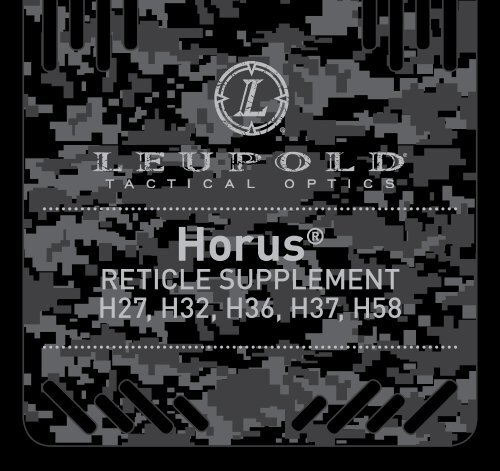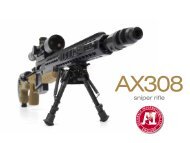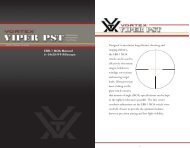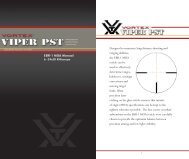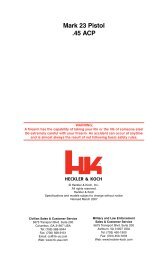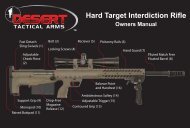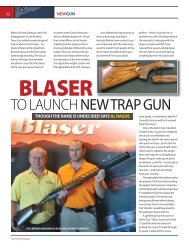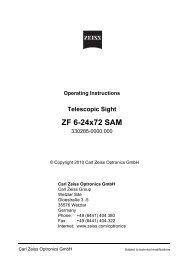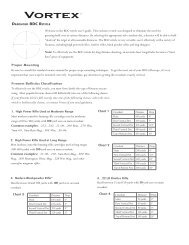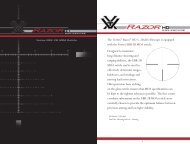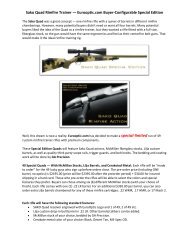Horus® - Leupold
Horus® - Leupold
Horus® - Leupold
You also want an ePaper? Increase the reach of your titles
YUMPU automatically turns print PDFs into web optimized ePapers that Google loves.
Horus ®RETICLE SUPPLEMENTH27, H32, H36, H37, H58
Table of ContentsThe Horus Reticles . . . . . . . . . . . . . . . . . . . . . . . . . . . . . . . . . . . . . . . . . . . . . Page 2Parts of the Mil-Based Reticles . . . . . . . . . . . . . . . . . . . . . . . . . . . . . . . . . . . Page 3Using the Data Obtained with Mil-Based Reticles . . . . . . . . . . . . . . . . . . . Page 7<strong>Leupold</strong> Technical Service . . . . . . . . . . . . . . . . . . . . . . . . . . . . . . . . . . . . . . Page 24
The Horus ReticleProducts containing Horus reticles are produced under license from Horus Vision, LLC.The Horus ® reticles are uniquely engineered to facilitate shooting at any numberof unknown ranges without mechanical adjustment. Horus reticles are designedto easily solve many of the complex issues facing long range shooters. Whenproperly utilized, Horus reticles can be used for range estimation, holdover andwindage correction, leading moving targets, second shot correction, and bracketsnap shooting with both supersonic and subsonic ammunition.Horus reticle markings are calibrated in mil-based increments, allowing forprecise measurement to the nearest 1/10 mil. When zeroing Horus reticles, themain crosshair should be precisely zeroed to match the point of impact at 100meters.2
3Parts of Mil-Based ReticlesA milliradian is a unit of measure derived from the degrees of a circle (in a 360degree circle, there are 6,283.2 milliradians, or 17.45 milliradians per degree).This means that a milliradian will subtend different amounts at differentranges. For example:The subtension of 1 mil equals 3.6 inches (3.44 MOA) at 100 yards or 36 inchesat 1,000 yards. In metric units, the correspondence is 1 mil equals 10 centimetersat 100 meters or 1 meter at 1,000 meters. Knowing this subtension andknowing the size of the target (or a reference object near the target) allowsthe distance to the target to be estimated with considerable accuracy.
The base scale for Horus reticles is .1 milliradians. The scale can be visually subdividedand/or combined by a trained user to produce infinite milliradian referencecombinations for limitless target ranging, leading, or holdover precision.Since the holdover features are presented in milliradian increments, they can becorrelated to any ballistic trajectory or used to estimate windage and lead movingtargets in the same manner as all milliradian based reticles.To use a Horus reticle simply determine the range to the target using the milsystem, then use the corresponding aiming point that is matched to your cartridgeto engage the target.FIRST VERSUS SECOND FOCAL PLANEAll Horus reticles located in the first/front focal plane provide accurate subtensionvalues regardless of the magnification setting used. The easiest way todetermine if the reticle is in the first focal plane is to view the reticle throughthe scope while changing the magnification setting. If the size of the reticleappears to change as the magnification setting is changed, the reticle is in thefirst focal plane. If it does not appear to change size, it is in the second focalplane. If the reticle is in the first focal plane, no specific magnification settingis required to obtain the proper subtension to yield accurate range estimatingresults.4
5THE USE OF MIL-BASED RETICLESTo use Horus reticles, you must know the actual size of the target.1. View the target through the scope.2. Place the center of the crosshair against one edge (top, bottom, oreither side) of the target so that the crosshair extends along eitherits width or height.3. Using the hash marks, measure along the crosshair to the oppositeedge of the target.If the center of the crosshair is against one edge of the target andthe opposite edge of the target is positioned behind the centerof the second mil mark, the target measures 2 mils. If it is exactlybetween the second and third mil mark, it measures 2.5 mils, etc. Themore specific you are in your estimation of the size of the target inmils (2.75 mils, etc.), the more accurate your results will be. This isespecially important in estimating the range of a small target or inestimating the range of a target at a great distance (i.e. beyond 500yards). Once the measurement of the target has been determinedin mils, the range can be estimated. This can be done in two ways;either by consulting the charts in this manual or by using thefollowing formula:
(Height of Target in Yards x 1,000) ÷ Height of Target in Mils = Rangeof the Target in YardsThis formula will also give results in metric terms if meters instead ofyards are used in the equation.For your convenience, <strong>Leupold</strong> has included range estimating tables(see Tables 1-8). To use these tables, locate the actual size of thetarget along the top of the table and the apparent size of the target,as measured in mils, along the side of the table. Follow both untilthey converge. This is the estimated distance to the target.6
7Using the Data ObtainedWith Mil-Based ReticlesOnce you have estimated the distance to the target with the reticle, thereare two primary methods of using this information. Both require that youknow the specific bullet drop of the ammunition you are using, measured inmilliradians.If your bullet drop has been measured in inches, a conversion to MOA willneed to be applied using the formula below.(Bullet Drop in Inches ÷ 1.047)= Bullet Drop in MOATarget Distance in Hundreds of Yards/MetersOnce the bullet drop has been measured in MOA, use the formula below toconvert MOA to mils:Bullet Drop in MOA= Bullet Drop in mils3.44
Example 1: If you have a 500 yard/meter shot and you know your bulletdrops 65 inches at that distance, you would follow the steps below:Convert 65 inches to MOA:(65" ÷ 1.047)=62= 12.4 MOA55Convert MOA to mils:12.4 MOA= Bullet drop in mils = 3.63.44 MOA per milThis bullet would be dropping 3.6 mils at 500 yards.Example 2: If your bullet drops 130 Inches at 650 yards/meters, the processwould look like this:(130" ÷ 1.047)=124= 19 MOA6.56.519 MOA= Bullet drop in mils = 5.53.44 MOA per milThis bullet would be dropping 5.5 mils at 650 yards.Note: The numbers used in the calculations above have been rounded and are forexplanation purposes only.8
9Dialing the Correction Into the ScopeThe most effective way to use the estimated distance is to dial the necessarycorrection into the scope using the elevation adjustment. If your scope featuresa bullet drop compensation dial, simply dial the correction directly according tothe distance marked on the elevation dial. If your scope does not have a bulletdrop compensation dial and your bullet drop has been measured in milliradians,simply use the elevation adjustment to make the appropriate correction.For example, if you need to allow for a bullet drop of 2 mils, you will simplydial 2 mils (20 clicks) in the up direction.Holding Over Using the HORUS ReticleSSometimes there isn’t time for correction using the scope’s adjustment mechanisms.In these cases, holding over the target and using the reticle’s markingsas an aiming point is useful. It must be remembered that holding over is not asexact as dialing elevation.
111315171921232527293133353757131 19 9U.S.Pat. 6.032.374U.S.Pat. 5.920.99513571113151719212325272931333537Horus H27 Reticle SUBTENSIONS1 1113355779 91111H 27DETAIL VIEW XNON-ILLUMINATED131513155.0 mil = 18.000" 0.20 mil = 0.720"@100 Yards 1.0 mil = 3.600" 0.15 mil = 0.54"0.5 mil = 1.800" 0.10 mil = 0.360"0.4 mil = 1.400" 1.0 mil = 3.438 Minutes of Angle = 3.600"10
11Horus H32 Reticle SUBTENSIONSDETAIL VIEW XNON-ILLUMINATED5.0 mil = 18.000" 0.20 mil = 0.720"@100 Yards 1.0 mil = 3.600" 0.15 mil = 0.54"0.5 mil = 1.800" 0.10 mil = 0.360"0.4 mil = 1.400" 1.0 mil = 3.438 Minutes of Angle = 3.600"
Horus H36 Reticle SUBTENSIONSDETAIL VIEW XNON-ILLUMINATED5.0 mil = 18.000" 0.20 mil = 0.720"@100 Yards 1.0 mil = 3.600" 0.15 mil = 0.54"0.5 mil = 1.800" 0.10 mil = 0.360"0.4 mil = 1.400" 1.0 mil = 3.438 Minutes of Angle = 3.600"12
13Horus H37 Reticle SUBTENSIONSDETAIL VIEW XNON-ILLUMINATED5.0 mil = 18.000" 0.20 mil = 0.720"@100 Yards 1.0 mil = 3.600" 0.15 mil = 0.54"0.5 mil = 1.800" 0.10 mil = 0.360"0.4 mil = 1.400" 1.0 mil = 3.438 Minutes of Angle = 3.600"
Horus H58 Reticle SUBTENSIONSDETAIL VIEW XNON-ILLUMINATED5.0 mil = 18.000" 0.20 mil = 0.720"@100 Yards 1.0 mil = 3.600" 0.15 mil = 0.54"0.5 mil = 1.800" 0.10 mil = 0.360"0.4 mil = 1.400" 1.0 mil = 3.438 Minutes of Angle = 3.600"14
15YIELDS ESTIMATED TARGET DISTANCE IN YARDSAPPARENT SIZE OF THE TARGET IN MILSACTUAL SIZE OF THE TARGET IN INCHES OR YARDSINCHES 9 12 16 18 20 22 24 28 32YARDS 0.250 0.333 0.444 0.500 0.556 0.611 0.667 0.778 0.8891.00 MIL 250 333 444 500 556 611 667 778 8891.25 MIL 200 267 356 400 444 489 533 622 7111.50 MIL 167 222 296 333 370 407 444 519 5931.75 MIL 143 190 254 286 317 349 381 444 5082.00 MIL 125 167 222 250 278 306 333 389 444Table 1
YIELDS ESTIMATED TARGET DISTANCE IN YARDSAPPARENT SIZE OF THE TARGET IN MILSACTUAL SIZE OF THE TARGET IN INCHES OR YARDSINCHES 9 12 16 18 20 22 24 28 32YARDS 0.250 0.333 0.444 0.500 0.556 0.611 0.667 0.778 0.8891.0 MIL 250 333 444 500 556 611 667 778 8891.5 MIL 167 222 296 333 370 407 444 519 5932.0 MIL 125 167 222 250 278 306 333 389 4442.5 MIL 100 133 178 200 222 244 267 311 3563.0 MIL 83 111 148 167 185 204 222 259 2963.5 MIL 71 95 127 143 159 175 190 222 2544.0 MIL 63 83 111 125 139 153 167 194 2224.5 MIL 56 74 99 111 123 136 148 173 1985.0 MIL 50 67 89 100 111 122 133 156 1785.5 MIL 45 61 81 91 101 111 121 141 1626.0 MIL 42 56 74 83 93 102 111 130 1486.5 MIL 38 51 68 77 85 94 103 120 1377.0 MIL 36 48 63 71 79 87 95 111 1277.5 MIL 33 44 59 67 74 81 89 104 1198.0 MIL 31 42 56 63 69 76 83 97 1118.5 MIL 29 39 52 59 65 72 78 92 1059.0 MIL 28 37 49 56 62 68 74 86 999.5 MIL 26 35 47 53 58 64 70 82 9410.0 MIL 25 33 44 50 56 61 67 78 89Table 216
17YIELDS ESTIMATED TARGET DISTANCE IN YARDSAPPARENT SIZE OF THE TARGET IN MILSACTUAL SIZE OF THE TARGET IN FEET OR YARDSFEET 3 4 5 6 7YARDS 1.0 1.3 1.7 2.0 2.31.0 MIL 1,000 1,333 1,667 2,000 2,3331.5 MIL 667 889 1,111 1,333 1,5562.0 MIL 500 667 833 1,000 1,1672.5 MIL 400 533 667 800 9333.0 MIL 333 444 556 667 7783.5 MIL 286 381 476 571 6674.0 MIL 250 333 417 500 5834.5 MIL 222 296 370 444 5195.0 MIL 200 267 333 400 4675.5 MIL 182 242 303 364 4246.0 MIL 167 222 278 333 3896.5 MIL 154 205 256 308 3597.0 MIL 143 190 238 286 3337.5 MIL 133 178 222 267 3118.0 MIL 125 167 208 250 2928.5 MIL 118 157 196 235 2759.0 MIL 111 148 185 222 2599.5 MIL 105 140 175 211 24610.0 MIL 100 133 167 200 233Table 3
YIELDS ESTIMATED TARGET DISTANCE IN METERSAPPARENT SIZE OF THE TARGET IN MILSACTUAL SIZE OF THE TARGET IN CENTIMETERSCENTIMETERS 30 40 50 60 70 80 901.00 MIL 300 400 500 600 700 800 9001.25 MIL 240 320 400 480 560 640 7201.50 MIL 200 267 333 400 467 533 6001.75 MIL 171 229 286 343 400 457 5142.00 MIL 150 200 250 300 350 400 450Table 418
19YIELDS ESTIMATED TARGET DISTANCE IN METERSAPPARENT SIZE OF THE TARGET IN MILSACTUAL SIZE OF THE TARGET IN CENTIMETERSCENTIMETERS 30 40 50 60 70 80 901.0 MIL 300 400 500 600 700 800 9001.5 MIL 200 267 333 400 467 533 6002.0 MIL 150 200 250 300 350 400 4502.5 MIL 120 160 200 240 280 320 3603.0 MIL 100 133 167 200 233 267 3003.5 MIL 86 114 143 171 200 229 2574.0 MIL 75 100 125 150 175 200 2254.5 MIL 67 89 111 133 156 178 2005.0 MIL 60 80 100 120 140 160 1805.5 MIL 55 73 91 109 127 145 1646.0 MIL 50 67 83 100 117 133 1506.5 MIL 46 62 77 92 108 123 1387.0 MIL 43 57 71 86 100 114 1297.5 MIL 40 53 67 80 93 107 1208.0 MIL 38 50 63 75 88 100 1138.5 MIL 35 47 59 71 82 94 1069.0 MIL 33 44 56 67 78 89 1009.5 MIL 32 42 53 63 74 84 9510.0 MIL 30 40 50 60 70 80 90Table 5
YIELDS ESTIMATED TARGET DISTANCE IN METERSAPPARENT SIZE OF THE TARGET IN MILSACTUAL SIZE OF THE TARGET IN METERSMETERS 1.00 1.25 1.50 1.75 2.001.00 MIL 1,000 1,250 1,500 1,750 2,0001.50 MIL 667 833 1,000 1,167 1,3332.0 MIL 500 625 750 875 1,0002.5 MIL 400 500 600 700 8003.0 MIL 333 417 500 583 6673.5 MIL 286 357 429 500 5714.0 MIL 250 313 375 438 5004.5 MIL 222 278 333 389 4445.0 MIL 200 250 300 350 4005.5 MIL 182 227 273 318 3646.0 MIL 167 208 250 292 3336.5 MIL 154 192 231 269 3087.0 MIL 143 179 214 250 2867.5 MIL 133 167 200 233 2678.0 MIL 125 156 188 219 2508.5 MIL 118 147 176 206 2359.0 MIL 111 139 167 194 2229.5 MIL 105 132 158 184 21110.0 MIL 100 125 150 175 200Table 620
21value of mils in inches at distanceS measured in yardsDISTANCE TO THE TARGET IN YARDSYARDS 100 150 200 250 300 350 400 450 5001.0 MIL 3.6 5.4 7.2 9.0 10.8 12.6 14.4 16.2 18.01.5 MIL 5.4 8.1 10.8 13.5 16.2 18.9 21.6 24.3 27.02.0 MIL 7.2 10.8 14.4 18.0 21.6 25.2 28.8 32.4 36.0MILS2.5 MIL 9.0 13.5 18.0 22.5 27.0 31.5 36.0 40.5 45.03.0 MIL 10.8 16.2 21.6 27.0 32.4 37.8 43.2 48.6 54.03.5 MIL 12.6 18.9 25.2 31.5 37.8 44.1 50.4 56.7 63.04.0 MIL 14.4 21.6 28.8 36.0 43.2 50.4 57.6 64.8 72.04.5 MIL 16.2 24.3 32.4 40.5 48.6 56.7 64.8 72.9 81.05.0 MIL 18.0 27.0 36.0 45.0 54.0 63.0 72.0 81.0 90.0Table 7
value of mils in CENTIMETERs at distanceS measured in METERSDISTANCE TO THE TARGET IN METERSMETERS 100 150 200 250 300 350 400 450 5001.0 MIL 10.0 15.0 20.0 25.0 30.0 35.0 40.0 45.0 50.01.5 MIL 15.0 22.5 30.0 37.5 45.0 52.5 60.0 67.5 75.02.0 MI 20.0 30.0 40.0 50.0 60.0 70.0 80.0 90.0 100.0MILS2.5 MIL 25.0 37.5 50.0 62.5 75.0 87.5 100.0 112.5 125.03.0 MIL 30.0 45.0 60.0 75.0 90.0 105.0 120.0 135.0 150.03.5 MIL 35.0 52.5 70.0 87.5 105.0 122.5 140.0 157.5 175.04.0 MIL 40.0 60.0 80.0 100.0 120.0 140.0 160.0 180.0 200.04.5 MIL 45.0 67.5 90.0 112.5 135.0 157.5 180.0 202.5 225.05.0 MIL 50.0 75.0 100.0 125.0 150.0 175.0 200.0 225.0 250.0Table 822
23LEUPOLD MAKES MORE THAN SCOPESSee our complete line of rangefinders, mounting systems, binoculars, spottingscopes, flashlights, and accessories at your nearest <strong>Leupold</strong> dealer.For a free <strong>Leupold</strong> catalog, write to:<strong>Leupold</strong> & Stevens, Inc., P.O. Box 688, Beaverton, OR 97075,call (503) 526-1400 or (800) LEUPOLD (538-7653),or send us an E-mail through our Web site at www.leupold.com.
<strong>Leupold</strong> Technical ServiceTo contact <strong>Leupold</strong> Technical Service or to get a free catalog, write to:<strong>Leupold</strong> & Stevens, Inc., P.O. Box 688, Beaverton, OR 97075-0688;call 1 800 LEUPOLD (538-7653) or (503) 526-1400; or send us an e-mailthrough our Web site at www.leupold.com.LEUPOLD, GOLDEN RING, MARK 4, the Golden Ring design, the circle-L reticle logo design, and various other marks are registeredtrademarks of <strong>Leupold</strong> & Stevens, Inc. All marks, including corporate logos and emblems, are subject to <strong>Leupold</strong>’s rights andmay not be used in connection with any product or service that is not <strong>Leupold</strong>’s, or in any manner that disparages or discredits<strong>Leupold</strong>, or in a manner likely to cause confusion.Certain other trademarks used in connection with <strong>Leupold</strong> products and services are the property of their respective owners,and are used with permission. BOONE AND CROCKETT CLUB and BOONE AND CROCKETT are registered trademarks of theBoone and Crockett Club. NWTF is a registered trademark of the National Wild Turkey Federation. QDMA, and QUALITY DEERMANAGEMENT are trademarks or registered trademarks of the Quality Deer Management Association. RMEF and ROCKYMOUNTAIN ELK FOUNDATION are registered trademarks of the Rocky Mountain Elk Foundation. ADVANTAGE TIMBER andADVANTAGE TIMBER HD are trademarks or registered trademarks of Jordan Outdoor Enterprises Ltd. MOSSY OAK BREAK-UP,MOSSY OAK BRUSH, MOSSY OAK OBSESSION, and MOSSY OAK TREESTAND are trademarks or registered trademarks of HAASOutdoors, Inc. A.R.M.S. is a registered trademark of Atlantic Research Marketing Systems, Inc. The ARD (anti-reflection device) ismanufactured by Tenebraex Corp. under the name KillFlash, which is a trademark of Tenebraex Corp.We reserve the right to make design and/or material modifications without prior notice.Copyright © 2011 <strong>Leupold</strong> & Stevens, Inc. All rights reserved.24
25Notes
Notes26
www.leupold.comPart# 114663Artwork# 114662


